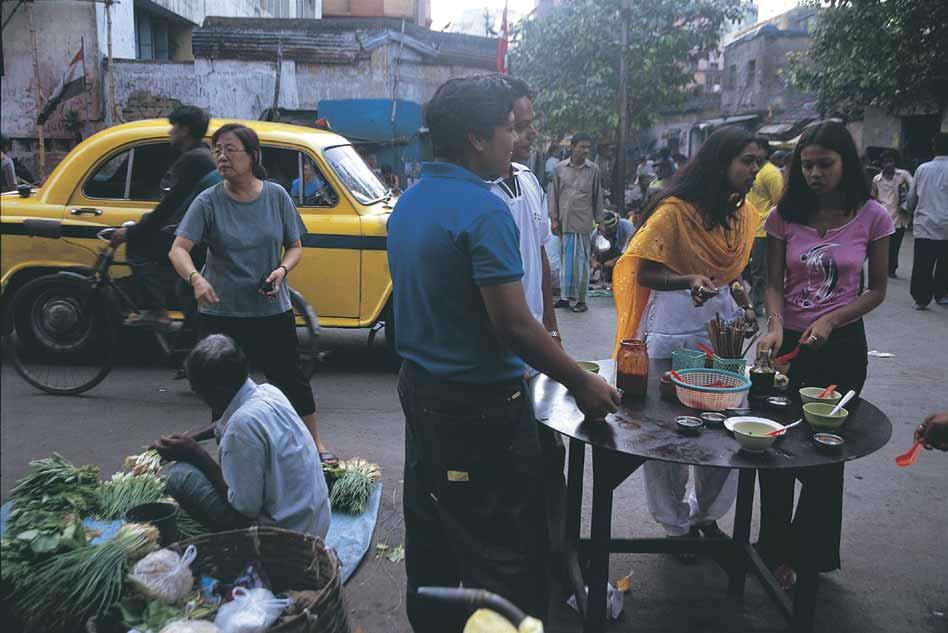It’s 6am, Tiretta Bazaar, Calcutta, and we’re doing the Chinese breakfast on Bentinck Street the right way.
The wrong way to do this is to wake up at 5am in order to make a special trip here. That’s the tourist method, and it guarantees disappointment.
The first time I went there, I didn’t get it. Calcutta is famous for its Chinese food. The community was among the first group of migrants to settle in the malarial swamp of Sutanuti and Kalighat, back in 1780. Cal Chinese has a bit of mainland, a touch of the original Cantonese, the subtlety and strength of the original flavours married to Bengali ingredients and cooking styles. Those who can stand the stink swear by the food at Tangra, where you get great Chinese food in the middle of Calcutta’s most pungent tannery. Those who have sensitive noses could pretty much throw a stone anywhere on Calcutta’s streets and still find a decent Chinese restaurant or noodle shack.
But the famous Bentinck Street breakfast was simultaneously alien, and on a smaller scale than I had anticipated. We got there early: the vendors were just setting up when we turned into Tiretta Bazaar. They were serving strictly home-style, no-concessions-to-the-stupid-gaijin-palate food to a smattering of customers; by 7am, most of the food would have sold out.
There were light soups — basic broths with a few greens and the odd chicken foot stirred in. There were heavier, spicier broths, including one in which the twin hammers of Sichuan chillies and pickled garlic drowned out the fishballs: we called it Krakatoa soup because it carved out an instant lava-filled crater in your stomach. There was steamed pao, soft Chinese bread with a variety of fillings: minced pork, fish innards, a complex vegetable mix that turned out to be the trimmings from herbs and Chinese greens mixed with fungus, sweet plum stuffing.
One gentleman served spicy Chinese sausage with what tasted like slimy scrambled eggs and turned out to be fresh pig brains cooked with blood and white stock: an unusual take on sausages and fried eggs. Noodles appeared only in soups — the women explained that no one but a barbarian would eat noodles for breakfast. Unless the noodles were cold, in which case they qualified as civilised food.
You could buy ready-to-fry prawn chips, dried greens, blocks of soup stock, strings of fat purple sausages and homemade soya sauce. Sometimes, a conversation, a story, would come free with the purchase. That was always worth it. More than the Armenians or the Anglo-Indians, the Chinese had remained slightly outside mainstream Calcutta. Chinatown was once a sprawling, self-sufficient area where blue Mao suits outnumbered saris and dhotis, but over the years the Chinese presence in Calcutta had dwindled. The younger generation left first, for Australia or the US, and now their parents were migrating, too. Most of the women with their stockpots and woks were there to earn a few extra bucks. Some, like Mrs Hu, had a different reason. “My grandmother’s recipe,” she said of the fishball soup. She was here because her mother had been here for years, at this street corner, selling soup at 6am. “To share our food,” she said. “To remind us what real Chinese food is.”
On subsequent visits, there were fewer locals stepping up for breakfast — never a good sign. Steamed and fried momos replaced the pau-sellers, the eel man packed up for want of business; the soups lost their complexity and gained cornflour.
But then the food had never been the point of the Chinese breakfast, even for the most nostalgic old-timers. With some exceptions, like the woman whose old-fashioned flower soup sold out in 10 minutes flat, most offered basic and sometimes barely passable home cooking. The atmosphere was never picturesque. The ‘stalls’ are basic; some vendors need nothing more than a gnarled wooden stool and a large cooking pot. Tiretta Bazaar’s seediness does not translate into exotic local colour. But the price is a draw: you could, and still can, eat yourself sick and have change coming back from a hundred bucks.
For every generation that grows up in Calcutta, doing the Bentinck Street breakfast is a rite of passage. Perhaps we’re hopeless romantics, looking for ‘authentic’ Chinese. Perhaps we’re paying tribute to a community that has been so much part of Calcutta, and so rarely celebrated: there are fewer accounts of the Chinese than there are of any of the other communities who once made Calcutta a cosmopolitan city. Perhaps we’re honouring a tradition the Chinese brought back from the bustling markets of the Far East, where the best food was roadside food. Perhaps we’re just cookpot voyeurs, hoping to find a small sliver of family histories mixed in with the shredded ginger. Or perhaps it’s just that when you’ve been up all night, you need to stroll over and see the moon over Bentinck Street.
Chinese food in Kolkata
Kolkata's China town
Leave a Reply
You must be logged in to post a comment.


